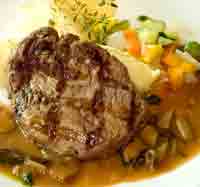|
Ironage-well.org > A -Z Minerals – Page 1 -Macro Minerals > Iron By Jennifer Sofia Catalano
What is Iron?
Iron is the second most abundant metal on earth and its use is traced back to the last 5000 years. In human physiology, this mineral is needed to transport oxygen from the lungs to the rest of our body and carbon dioxide back to the lungs, but also for storing and releasing oxygen in muscle cells. This is done via the haemoglobin in the red blood cells which travel round our organs.
How is it acquired, stored and excreted?This important element is mostly present in haemoglobin, in red blood cells and therefore any loss of blood (e.g. menstruating women) means a loss of this mineral which needs to be replaced. It is so vital to the body, that it is not excreted as such but is lost through sweating, dead skin cells and also from the mucus in the lining of the intestine. This nutriant is replaced through our diet and it is our intestine (in particular our duodenum) which regulates how much we need to absorb from what we eat. Factors which influence how much of this mineral our body absorbs, revolve around how much is already stored in our system, how much haemoglobin and oxygen there is in the blood and how many new red blood cells are being made. It is stored primarily in the liver cells but also the bone marrow and spleen.
How Much Should We Take?Recommended Dietary Allowances for Infants,
Children, and Adults taken from the Office of Dietary Supplements.
Who is most at risk of deficiency?Growth in human bodies requires even more than usual. Therefore pregnant women and children require more than other groups. Women who menstruate, people who have lost blood or blood donors need to compensate for what has been lost. People who suffer from gastro-intestinal diseases need to compensate for any intestinal blood loss and/or poor absorption. Adult men and postmenopausal women are therefore least likely to be deficient in this mineral, and furthermore are discouraged from taking supplements since they are more at risk of having too much of it. What are the Symptoms of Deficiency?If we are deficient in this mineral our bodies begin by consuming the reserves we have stored, and then the iron in the haemoglobin. A blood test for haemoglobin, reveals if the concentration is adequate, and if it is not, then supplements are administered. Since this mineral is vital to growth in humans, its deficiency in children impairs physical and cognitive growth. More generally, since it carries oxygen to our tissues and muscle, if we lack this mineral, we suffer fatigue and low physical productivity. Interestingly, it has been noted that people who eat dirt or clay (condition known as pica, geophagia) are typically deficient, though scientists have not yet confirmed how this link is scientifically explained. What happens if too much is present in the body?
Which foods contains Iron?This mineral is essential to plants and animals and it is therefore found in eating both, however its form changes between the two, and its absorption is also subject to the presence of other chemicals and minerals in the intestine at the same time.
Nutrient values from Agricultural Research Service (ARS) Nutrient Database for Standard Reference, Release 17. Foods are from ARS single nutrient reports, sorted in descending order by nutrient content in terms of common household measures. Food items and weights in the single nutrient reports are adapted from those in the 2002 revision of the USDA Home and Garden Bulletin No. 72, Nutritive Value of Foods. Mixed dishes and multiple preparations of the same food item have been omitted from this table. For foods not listed in this table, please refer to the U.S. Department of Agriculture's Nutrient Database Web site at the following URL : http://www.nal.usda.gov/fnic/cgi-bin/nut_search.pl
Health TipFor a calorie-free way to get your daily iron, consider adding an iron supplement to your vitamin regimen. Iron supplements are an easy way to help reverse and prevent iron deficiency anemia and its resulting symptoms. Consult with your doctor to determine your appropriate dosage and ask if a high-potency iron supplement is right for you. Sourceshttp://en.wikipedia.org/wiki/Human_iron_metabolism http://ods.od.nih.gov/factsheets/iron.asp http://en.wikipedia.or/wiki/Iron_deficiency_(medicine) http://emedicine.medscape.com/article/166933-overview http://www.nhlbi.nih.gov/health/dci/Diseases/ida/ida_whoisatrisk.html http://whqlibdoc.who.int/publications/2008/9789241596657_eng.pdf To see above pages, please cut and paste the URL into your browser. TOP of Iron
age-well.org > A -Z Minerals – Page 1 - Macro Minerals > Iron |
Translate this Site
Search This Site
Loading
Subscribe to E-Zine
Support this Site
|
Holiday SpecialsFor Holiday Specials at Amazon, Click Here
|
| |||||





